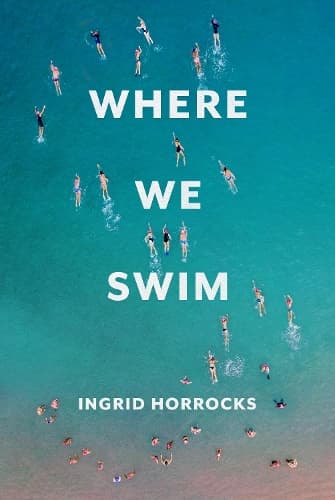Review: Where We Swim
Reviewed by Hannah Tunnicliffe
Reviewed by: Hannah Tunnicliffe
Author:Ingrid Horrocks
Publisher:Victoria University Press
ISBN:9781776563135
Date Published:09 March 2021
Pages:224
Format:Paperback
RRP:$35.00
Though author Ingrid Horrocks titles her exploratory and reflective book Where We Swim, it could just as easily have been titled “What We Swim,” “How We Swim” or “Why We Swim” as Horrocks takes us with her into moana, awa and swimming pools from Onetangi to Colombia, immersing us in questions about ecology, community, whānau and spirituality.
If you are looking for a book that fits squarely into a genre, Where We Swim might be too fluid for you. With its soothing turquoise cover, dotted with swimmers in pink caps, I presumed it would feature a series of solo swimming challenges and personal quests but Horrocks dispels this immediately admitting that she’d considered the idea but thought that approach would be “too deliberate, too intentional, and too solitary”.
Besides, she confesses, “Not that I can really swim… As a swimmer, I have few aspirations to mastery.” Instead Horrocks opts instead for a mix of memoir, essays, nature writing and travel journeys, all with swimming or simply being in water at the centre — “the breathing core of things” — and ultimately produces a book that is simultaneously contemplative, considered, earnest and charming.
For a lover of travel, Horrocks’ swims provide a seductive reminder of the places we used to go, pre-Covid, as she dips in pools in Medellín, the Amazon, Phoenix and the utopian desert community of Arcosanti. She writes with wonder about these adventures; beautifully describing small rugby-ball sized avocados, manatees in captivity, her children’s joy at a whale’s tail splashing in a harbour, shooting stars in a desert and an elk spotted at dawn.
In Oak Creek Canyon, California, we join Horrocks as she experiences a terrifying natural waterslide, careening down algae-slick rock and plunging into bracing, four-degree water. Finally, closer to home, Horrocks visits a brother and beaches in Perth and then heads to Sussex, England to reminisce about her time at the University of York where she completed a thesis analysing family travels and women’s travel journals; study which clearly established a lifetime theme.
“In Aotearoa, swimming is what people do.”
Happily, Horrocks treats her version of travel writing as an opportunity to explore the interconnections between people and their places, communities and their impact on the natural world. She points out the impact of development, tourism, global warming and colonisation, not shy to acknowledge her contribution to all of the above in some way. Plus, she never pretends to be a lone explorer, always recognising and discussing her roles as daughter, wife, teacher, creative, mother, daughter-in-law and sister. She understands that everywhere and everyone is part of an ecosystem (or several).
Observations of her own twin daughters, Lena and Natasha, add notes of joy and levity to some of her weightier contemplations. The chapter concerning Arcosanti seems to encapsulate many of the themes found in Horrocks’ other essays: family, fragility, sustainability, hope, nature, collapse, beauty, strength and failure. (Arcosanti is a striking but imperfect utopian community in Arizona, founded by Italian-born architect and urban designer Paolo Soleri, who was accused of sexual abuse by his daughter.)
If Where We Swim is starting to sound too exotic for the times, rest assured that Horrocks writes about Aotearoa and our particular ecological and societal challenges also. Her at-home chapters feature wai you will likely be familiar with: Days Bay, Onetangi in Waiheke, Kāpiti coast, Tokomaru river and Raglan.
Horrocks discusses the pollution of our waterways, Wellington whale visits, taniwha and the recognition of Whanganui river’s legal personhood. She understands that swimming, for island dwellers like us, is restorative, affirming and unifying and the places we swim are vital to all our cultures, industries and life forms.
Or, as Horrocks simply states, “In Aotearoa, swimming is what people do.”
Beautiful, surprising, mysterious, deep and reflective, Where We Swim is a book that is much like the bodies of water we never forget.
Reviewed by Hannah Tunnicliffe
See in New Books
